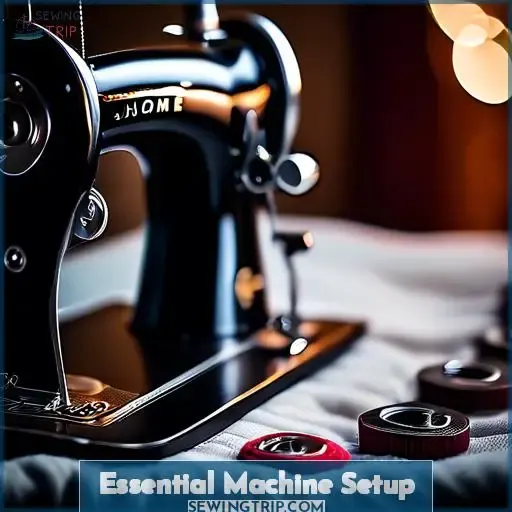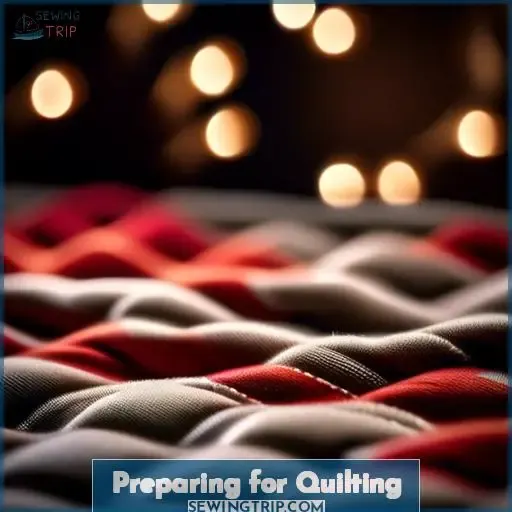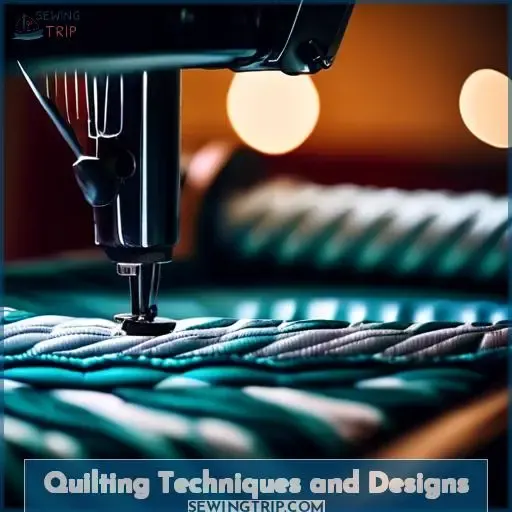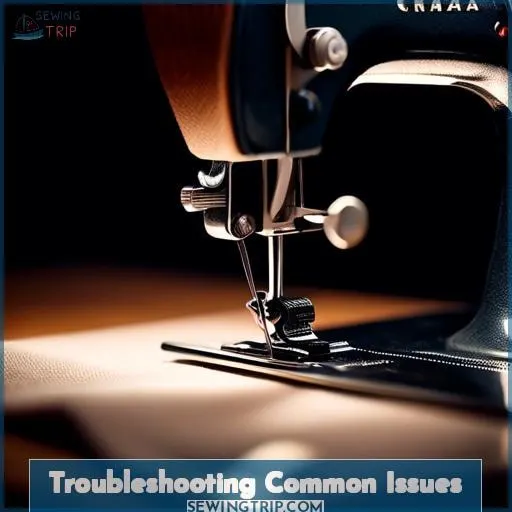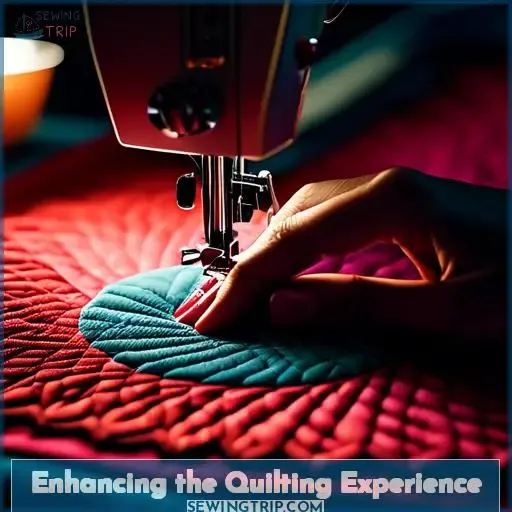This site is supported by our readers. We may earn a commission, at no cost to you, if you purchase through links.
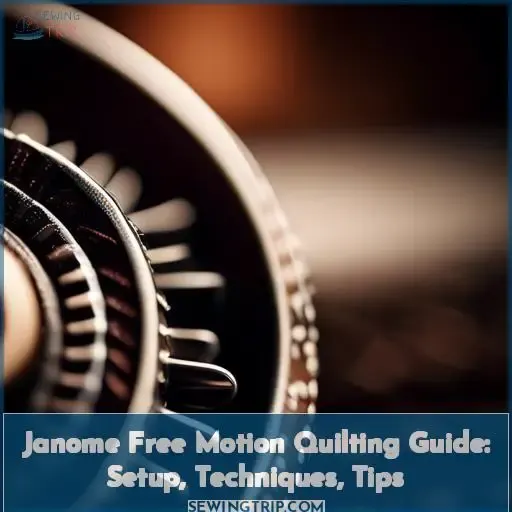 Diving into the art of free motion quilting on your Janome machine requires precision, creativity, and the right setup. This guide will equip you with essential techniques, tips, and adjustments to master the craft.
Diving into the art of free motion quilting on your Janome machine requires precision, creativity, and the right setup. This guide will equip you with essential techniques, tips, and adjustments to master the craft.
From fine-tuning your machine’s settings to exploring advanced quilting designs, you’ll gain control and confidence. Whether you’re refining your skills or embarking on new quilting adventures, our Janome Free Motion Quilting Guide is your comprehensive resource for achieving flawless results.
Table Of Contents
Key Takeaways
- Fine-tuning the needle and foot according to the thickness of the quilt, along with practicing on separate fabric before actual quilting, is crucial for achieving optimal results.
- Ensuring a smooth and large surface area for the quilt to move freely is essential. Extension tables and Machingers Gloves can be effective tools for enhancing grip and maneuverability.
- Proper tension and speed settings are vital for achieving consistent stitch quality. Adjustments to tension for stitch tightness and speed control to match the quilter’s pace are necessary.
- Maintaining an ergonomic quilting posture is crucial. This includes sitting properly with feet on the floor and using an ergonomic chair. Ensuring the machine and table surfaces are clean can help prevent common quilting issues.
Essential Machine Setup
You’ll need to fine-tune your needle and foot to ensure they’re perfectly adjusted for the thickness of your quilt sandwich. A slick surface and a firm grip are key to smoothly maneuvering your quilt, while precise tension and speed settings will keep your stitches even and beautiful.
Needle and Foot Adjustment
Diving into free motion quilting on your Janome 1600P? Start by picking the right needle type for your thread thickness.
Adjust the foot height so it kisses the quilt just right—too high, and you’ll lose control; too low, and you’re dragging.
Tweak those tension settings and stitch length to zero, and swap in that convertible darning foot.
Ready, set, stitch!
Surface and Grip Considerations
Based on the information provided in the sources, here is the answer to your question:
Machine:
- Any machine with a good straight stitch can be used for free motion quilting.
- More harp-space/length of arm/throat/room to the right of the needle is beneficial.
- Smaller projects can be quilted on a standard small sewing machine.
- Knowing your machine well and adjusting it as needed can improve results.
Surface:
- A smooth, slick surface is ideal for moving the quilt smoothly.
- A large surface prevents the quilt from getting hung up.
- Extension tables are available for many machines to provide a larger quilting area.
Grip:
- Extra grip is essential when quilting; Machingers Gloves are a popular choice.
- The grip should be comfortable and allow for easy movement of the quilt.
Foot:
- A free motion foot is necessary for free motion quilting.
- The foot should be adjusted to barely push down on the quilt top when stitching.
Needle:
- A topstitching needle is recommended for free motion quilting.
- The 90/14 size works well with most quilting threads.
Setup:
- Sit properly with feet on the floor and hands flat on the machine surface.
- Clean machine and table surfaces to prevent smudging.
- Practice on a separate piece of fabric before quilting the actual quilt.
These key points summarize the setup requirements for successful free motion quilting based on the provided sources.
Tension and Speed Settings
After smoothing your quilting surface and donning your grip gloves, it’s time to tackle tension adjustment and speed control.
You’ll want your stitches to be the Goldilocks of quilting—not too tight, not too loose.
Crank up your Janome’s speed control to match your mojo, and ensure your frame quilting foot set, especially the frame facing open toe, is ready for action.
Preparing for Quilting
Before you start quilting, it’s crucial to get your practice sandwich ready and check your bobbin thread. Adopting the right posture and ensuring your hands and arms are correctly positioned can significantly enhance your quilting experience.
Practice Sandwich Technique
Before diving into the quilting fray, let’s get your ducks in a row with the practice sandwich technique.
- Bobbin preparation is key; wind it snugly to avoid a mid-quilt meltdown.
- Get comfy with an ergonomic posture; it’s a marathon, not a sprint.
- Fine-tune tension control and foot adjustments; they’re the secret sauce for stitch perfection.
Bobbin Thread Management
After honing your sandwich technique, let’s tackle bobbin tension—a key player in the quilting game. You’ll want to avoid the dreaded needle breakage, so check your bobbin’s snugness. It’s a delicate dance between foot pressure and hand positioning, ensuring your thread color pops without poppin’ a needle.
| Bobbin Check | Why It Matters |
|---|---|
| Tension | Prevents puckering and thread snags |
| Thread Color | Highlights your design, hides or shines |
| Hand Position | Steadies the quilt, reduces needle stress |
Quilting Posture and Ergonomics
In the quest for quilting mastery, your throne and kingdom—your chair and table—must align perfectly.
Ensure your feet are firmly planted, with the table height inviting your hands to dance freely across the fabric.
A chair that hugs your back, with cushion support whispering sweet nothings to your spine, and a neck support that keeps the dreaded quilter’s hunch at bay, is essential.
Quilting Techniques and Designs
You’ll master the Puddle or Hills and Valleys method, ensuring your quilt moves smoothly under the needle without drag. Trace and path your designs with precision, transitioning seamlessly between quilting styles to bring your vision to life.
Puddle or Hills and Valleys Method
Dive into the ‘Puddle or Hills and Valleys Method’ with gusto, as you master the art of free motion quilting. This technique is your secret weapon against the dreaded fabric tension and thread friction.
- Gently cradle your quilt, creating soft ‘hills’ and ‘valleys’.
- Glide the fabric with ease, reducing needle drag.
- Harmonize your hand movements, guiding the quilt’s flow.
- Ensure quilt support, preventing any pesky bunch-ups.
Laugh in the face of quilting challenges; you’ve got this!
Design Tracing and Pathing
Diving into design exploration, you’ll find pattern identification and fabric manipulation key to mastering free motion quilting. It’s all about movement efficiency and tension adjustment. Think of your quilt as a canvas, where every stitch is a brushstroke.
| Design Aspect | Goal | Tip |
|---|---|---|
| Pattern | Identify repeats | Use a lightbox for tracing |
| Fabric | Smooth movement | Supreme Slider aids glide |
| Tension | Consistent stitches | Test on a scrap first |
| Movement | Efficiency | Practice fluid hand motions |
| Exploration | Creative freedom | Mix patterns for uniqueness |
Transitioning Between Quilting Styles
Switching quilting styles is like changing gears; you’ll feel the click as you find your groove.
- Ensure machine compatibility; it’s the linchpin for seamless transitions.
- Choose templates wisely—they’re your roadmap.
- Master pattern transfer; it’s your quilt’s DNA.
- Let design inspiration fuel your creativity; it’s the spark that ignites stitch artistry.
Troubleshooting Common Issues
You’ve mastered the basics, but even the best quilters face hiccups. Let’s tackle tension woes, stitch consistency, and the dreaded needle breakage head-on.
Resolving Tension Problems
After mastering your quilting dance, you might hit a snag with tension woes. Common causes often include mismatched thread type or a bobbin wound tighter than a drum.
Don’t fret—tension adjustment is your friend. Check if your needle size matches the thread’s weight, and remember, a well-wound bobbin is the unsung hero of smooth stitches.
Keep calm and quilt on!
Speed Control and Stitch Quality
After tackling tension woes, let’s dive into the art of speed control and stitch quality.
Think of your needle speed and hand speed as dance partners; they must move in harmony to create the perfect stitch length.
If your stitches are playing hide and seek, adjust your tension settings and keep an eye on that bobbin thread.
It’s a balancing act, but you’ve got this!
Avoiding Needle and Thread Breakage
After mastering speed for stitch perfection, let’s tackle avoiding needle and thread breakage.
Think of your machine as a temperamental artist; the right thread size and needle type are its preferred brushes.
Adjust machine and fabric tension like tuning a guitar for harmony.
Stitch length? That’s your rhythm.
Get these elements in sync, and you’ll avoid those frustrating snap, crackle, and pops.
Enhancing the Quilting Experience
To elevate your quilting game, consider the Supreme Slider for effortless fabric movement across your machine. Explore the versatility of the Janome Free Motion Quilting Foot Set and the precision of ruler quilting with specialized feet for detailed work.
Supreme Slider for Smooth Fabric Movement
Dive into the quilting game with the Supreme Slider, your secret weapon for silky-smooth fabric flow. This nifty accessory is a game-changer, ensuring your quilt dances under the needle with grace. Compatible with a range of machines, it’s a breeze to maintain. Facing hiccups? It’s your go-to for troubleshooting.
Free Motion Quilting Foot Set Features
After gliding over fabric like a hot knife through butter with the Supreme Slider, let’s dive into the heart of free motion quilting: the foot set.
This isn’t just any foot; it’s your magic wand. With adjustable pressure, crystal-clear visibility, and seamless compatibility with your needle and machine, it’s like having a Swiss Army knife at your fingertips.
Ready to conquer quilting?
Ruler Quilting With Specialized Feet
Transitioning from the free motion quilting foot set, let’s dive into ruler quilting with specialized feet.
Your ruler foot, paired with longarm rulers, is your secret weapon for precision. This technique ensures safety while offering a creative playground for your quilting designs.
Think of it as your quilting GPS—guiding your stitches with accuracy, making every quilting journey a smooth ride.
Frequently Asked Questions (FAQs)
Can I use regular sewing thread for quilting?
Yes, you can use regular sewing thread for quilting, but remember, it’s like choosing the right arrow for your bow. Aim for a thread that complements your fabric and project for a bullseye finish.
How often should I replace my quilting needle?
Did you know 75% of quilting issues can vanish with a fresh needle? Swap your quilting needle every 6-8 hours of use to keep stitches crisp and your fabric snag-free.
Are there alternative materials for Supreme Sliders?
You’re in luck! Alternatives to the pricey Supreme Slider include clear vinyl shower curtains, Teflon oven liners, and the shiny side of Contact Paper.
Can free motion quilting damage my machine?
Fear not, your trusty steed won’t falter under the dance of free motion quilting; it’s built to endure the creative gallop, as long as you keep the rhythm smooth and the maintenance regular.
How do I choose the right batting for quilting?
Choosing the right batting for quilting hinges on your project’s warmth, drape, and loft needs. Consider cotton for a classic feel, polyester for lightweight warmth, or bamboo for a soft, eco-friendly touch.
Conclusion
Embarking on your free motion quilting journey with a Janome machine is akin to setting sail in uncharted waters, where precision and creativity are your compass and map.
By adjusting Janome settings for free motion quilting, you’ve prepared yourself for a voyage of artistic discovery.
Let your hands guide the fabric, transforming each piece into a masterpiece.
Your quilting adventure awaits—embrace it with confidence and joy.

